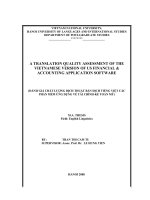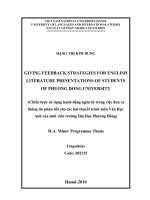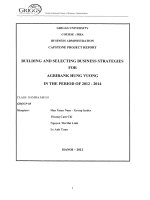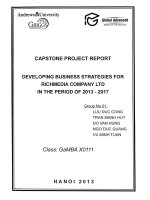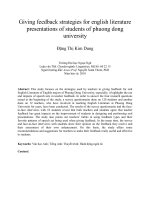The use of translation strategies for english idiomatic expression in the vietnamese version of pierce brown’s “red rising
Bạn đang xem bản rút gọn của tài liệu. Xem và tải ngay bản đầy đủ của tài liệu tại đây (199.78 KB, 39 trang )
MINISTRY OF EDUCATION AND TRAINING
HO CHI MINH CITY UNIVERSITY OF TECHNOLOGY
---------------------------
THE USE OF TRANSLATION STRATEGIES
FOR ENGLISH IDIOMATIC EXPRESSION IN
THE VIETNAMESE VERSION OF PIERCE
BROWN’S “RED RISING”
Major: English Language
Course code:
HO CHI MINH CITY, FEBRUARY/ 2023
MINISTRY OF EDUCATION AND TRAINING
HO CHI MINH CITY UNIVERSITY OF TECHNOLOGY
---------------------------
THE USE OF TRANSLATION STRATEGIES
FOR ENGLISH IDIOMATIC EXPRESSION IN
THE VIETNAMESE VERSION OF
PIERCE BROWN’S “RED RISING”
Submitted to the
Faculty of English Language
in partial fulfillment of the Master’s degree in English Language
(Total number of words should be stated here)
Course code: 60220201
By
HO CHI MINH CITY, FEBRUARY/ 2023
i
ABSTRACT
Keywords: idiomatic expression, translation, translation strategy.
ii
TABLE OF CONTENTS
ABSTRACT.................................................................................................................i
TABLE OF CONTENTS...........................................................................................ii
List of tables...............................................................................................................iv
LIST OF ABBREVIATIONS AND SYMBOLS......................................................vi
CHAPTER 1 INTRODUCTION................................................................................1
1.1 Background to the study....................................................................................1
1.2 Statement of the problem...................................................................................3
1.3 Aims and objectives of the study.......................................................................4
1.4 Research questions............................................................................................4
1.5 Scope of the study.............................................................................................4
1.6 Significance of the study...................................................................................5
1.7 Definition of the key terms................................................................................5
1.8 Organization of the thesis..................................................................................5
CHAPTER 2 LITERATURE REVIEW.....................................................................6
2.1 Introduction.......................................................................................................6
2.2 Idioms................................................................................................................6
2.2.1 Definitions of idioms...................................................................................6
2.2.2 Characteristics of idioms.............................................................................8
2.2.3 English idiomatic expressions.....................................................................9
2.3 Translation strategy.........................................................................................10
2.3.1 Definitions of translation strategy.............................................................10
2.3.2 Idiom translation.......................................................................................11
2.3.3 Idiom translation strategies.......................................................................12
2.4 Previous studies...............................................................................................15
2.5 Conceptual framework....................................................................................18
CHAPTER 3.............................................................................................................19
METHODOLOGY...................................................................................................19
3.1 Introduction.....................................................................................................19
3.2 Research design...............................................................................................19
iii
3.3 Data source......................................................................................................19
3.4 Sample and sampling procedures....................................................................20
3.5 Research instruments.......................................................................................20
3.6 Data collection procedures..............................................................................21
3.7 Data analysis procedures.................................................................................21
3.8 Validity & Reliability......................................................................................21
3.8.1 Validity......................................................................................................21
3.8.2 Reliability..................................................................................................22
3.9 Ethical issues...................................................................................................22
3.10 Chapter summary...........................................................................................22
CHAPTER 4 RESULTS AND DISCUSSIONS.......................................................22
4.1 Introduction.....................................................................................................22
4.2 Results.............................................................................................................22
4.3 Discussions......................................................................................................22
4.4 Chapter summary.............................................................................................22
CHAPTER 5 CONCLUSION...................................................................................23
5.1 Summary of the main findings of the thesis....................................................23
5.2 Implications of the research.............................................................................23
5.3 Limitation of the research................................................................................23
5.4 Recommendations for further research............................................................23
LIST OF REFERENCES..........................................................................................24
iv
LIST OF TABLES
v
LIST OF FIGURES
vi
LIST OF ABBREVIATIONS AND SYMBOLS
1
CHAPTER 1
INTRODUCTION
1.1 Background to the study
Language is an important part in every communication. People can
communicate well if they can deliver their message from their utterance. Language
allows people to say things to others and expresses their communicative needs.
Language and society may influence each other because as a human being, people
cannot be separated with society and environment and they still need another
people. Alternatively, we say that language is a mean of communication (William,
2005). The statement implies that persons must have a strong command of English.
But, those who never learn English or who do not know the language need
translated books or dictionaries to understand the meaning of a foreign word or
phrase so that they can comprehend the word, phrase, or sentence without difficulty.
In Vietnam, English is known as a foreign language, studied by many people
in the country, because it is used as a necessity and is used almost everywhere.
Sometimes, English is a big barrier because people misunderstand the meaning of
the sentence, so translation is one of the important tools to translate from English to
Vietnamese language. Translation is one effective way to understand the English
language with ease.
Translation is a two-party relationship (between target and source language)
that requires effective cooperation in order to get desired results. According to Bell
(1991), the purpose of translation is to change a text that was originally written in
one language into a text that has the same meaning but is written in a different
language while preserving as much of the formal characteristics and functional roles
of the original text as is possible. Bell (1974), in contrast to Catford, argues that a
total equivalence between a source language (SL) text and its translation is
something that can never be fully achieved. Since translation has grown in
significance on both a national and international scale, it is unquestionably a topic
2
deserving more in-depth research. To achieve a good translation, a translator must
have a good knowledge of the source language and the target language and their
culture. Nida (1964) also adds that a translator's job is to make it easier for a
message's meaning and cultural components to be transferred from one language
into another while also giving the listeners a comparable response. One of
challenges that translators meet is idiomatic expressions because they have literal
meaning and figurative meanings.
Idiomatic expressions are a fascinating and widespread occurrence in all
languages. They are commonly used in daily life to convey ideas and notions that
cannot be encapsulated in a single phrase. The consistently highlight the
distinctiveness of how each country views and responds to the outside world.
Huber-Okrainec and Dennis (2003) state that idioms are non-literal phrases that
cannot be translated literally. However, idiomatic expressions are used commonly
in spoken and written languages. In actuality, they are a regularly used component
of communication. According to Liu and Hwa (2018), understanding the intended
meaning of an idiom or idiomatic expression depends on the context in which it is
used. Additionally, Oakhill, Cain, & Nesi (2016) affirm the significance of its
context for general comprehension.
In general, it is crucial for a translator to first identify idiomatic expressions in
the source language before determining the best strategies for translating them. The
translator needs translation strategies so that the meaning of the idiom in the source
text may be managed appropriately in the target text because there are numerous
challenges in translating idioms. The translators employ the translation strategy to
aid them in translating idioms. According to Baker (2006), the translator must select
the best strategy so that the message of an idiomatic expression can be precisely and
effectively communicate. The ability to identify idiomatic expressions and use
appropriate translation strategies is thus enormously important. Therefore, the
researcher considers translation strategies for idiomatic expressions from English
into Vietnamese is an interesting and useful topic for discussion and exploration
3
when the needs for translating books, especially literals ones, from English into
Vietnamese are increasing. In bookstores, we can find that thousands of works have
been translatied from English into Vietnamese to serve Vietnamese readers of all
types.
1.2 Statement of the problem
The use of idiomatic expressions is almost essential in books, even though,
idioms are unique and tend to be difficult to be translated. In this study, the
translator chose a famous book, namely “Red Rising” by Pierce Brown, an
American science fiction author, wrote six novels and faced rejection from over 120
agents before selling Red Rising. He wrote this novel in two months above his
parents' garage in Seattle, Washington.
Red Rising is a 2014 dystopian science fiction novel of Pierce Brown, and the
first book and eponym of a series. The novel, set in the future on Mars, follows
lowborn miner Darrow as he infiltrates the ranks of the elite Golds. Red Rising has
received generally positive reviews. In 2014, Universal Pictures secured the rights
for a film adaptation, but the project was eventually scrapped. Red Rising was well
received by both readers and critics, and hit #20 on The New York Times Best
Seller list in February 2014.
The story depicts the Martian setting and future technologies of the Darrow
world in great detail and creativity. From the beginning of the story, the author has
focused on describing all aspects of the daily life of the residents of the Red class,
as well as the machinery and equipment they use in their daily lives and work.
Thanks to that, when reading the story, you can almost feel like walking around the
mining areas, shaking hands and chatting with Darrow himself. What's more, the
author doesn't hold each thing in his hand, one by one, but lets the story flow
naturally, and gradually the dialogues, the characters' inner thoughts will let the
reader understand. more about the context, about the technologies used. Thus, to
express common issues in life, the author uses a lot of idiomatic expressions. As a
4
results, the translation strategies for these idiomatic expressions and their
Vietnamese equivalents will serve as a useful source for translation teachers and
students.
1.3 Aims and objectives of the study
The aim of this research is to analyze strategies that the translator, i.e.Le
Dinh Chi, used in translating idiomatic expressions and to find out the most
frequent translation strategies so that useful implications can be achieved. To put it
specifically, the objectives of this study are:
-
To find out the idiomatic expressions in the English version Red Rising
by Pierce Brown.
-
To identify their Vietnamese equivalents in the Vietnamese version Do
troi day by Le Dinh Chi and the idiomatic expression translation
strategies that the translator used.
1.4 Research questions
1. What are the idiomatic expressions found in the English version Red Rising by
Pierce Brown?
2. What are their equivalents and translation strategies the translator use in
translating these idiomatic expressions into Vietnamese in the Vietnamese version
Do troi day by Le Dinh Chi?
5
1.5 Scope of the study
The study will focus on translation strategies including functions and meaning,
as well as Baker's translation theories for the translation of idiomatic expressions in
the English book. Consequently, register and genre aspects of Baker's model will
not be disclosed. This study will examine the data comprehensively using content
and descriptive analysis.
1.6 Significance of the study
This study is hoped to serve as a further resource for readers, particularly for
translation teachers and students who are interested in studying the strategies of
idiomatic expressions translation. These strategies are anticipated to be expanded
upon and further investigated by other researchers in future studies to get new
experience in researching idioms.
In terms of theory, this study will make a contribution for scholarly literature
and empirical studies to support applying of more objective as well as applicable
translation strategies for the Vietnamese and English languages.
As far as a practical contribution, this study will serve as a resource for both
amateur and professional translators seeking to enhance the overall quality of other
literary translations. In addition, the study may serve as a roadmap for future
research including the application of Baker's theories 1992 to the evaluation of
idiom translation strategies
1.7 Definition of the key terms
- Idiomatic expressions: According to McCharthy and O‘Dell (2003) in their book,
English Idiom Use states that, “idioms are expressions which have a meaning that is
not obvious from the individual word” (p.6). It means that the meaning of idioms is
not literal meanings, but they have non literal meanings. The best way to understand
6
idiom are by looking at the content. For example, drive somebody is an idiom
meaning make somebody angry or frustrated.
- Translation: Munday (2012) states that translation is transferring source languages
into target languages. The translation is needed to help the readers understand the
text meaning that originally from a foreign language into their first language.
- Idiomatic expression translation strategy: Krings (2013) defines translation
strategy as the ideas of translators who could be aware of some translation situations
and found a way for tickling any problems that occur in a concrete situation.
Loescher (2013) simply understood it as “a potentially conscious procedure that
translators found useful ways to solve the problem in translating a text, or any
segment of it” (p.33). An idiom of similar meaning and form, using an idiom of
similar meaning but dissimilar form, translation by paraphrase, and translation
omission.
1.8 Organization of the thesis
This study report comprises five separate chapters.
Chapter 1 provides an introduction to the study ….
Chapter 2 is the literature review, presenting ………..
Chapter 3 describes the methodology of the study ….
Chapter 4 provides a presentation of (1) the data collected from …, (2) discussion of
the data …
Chapter 5 presents ….
7
CHAPTER 2
LITERATURE REVIEW
2.1 Introduction
There are different literature aspects that need to be taken into consideration
when conducting a study on how to use translation strategies in translation. These
can be classified into two main categories: idiom and translation, focusing on the
strategies that the translators applied in the translation from English into
Vietnamese. Also, previous studies and research needs to be reviewed and
compared to show the gap in research. Lastly, a conceptual framework will be
proposed to lay the foundation for the research of the next chapter.
2.2 Idioms
2.2.1 Definitions of idioms
Idioms are a natural and important part of every language but we hardly ever
pay attention to the amount to which we employ idioms in our regular speech.
According to Langacher (1968), “an idiom is a kind of complex lexical item. It is a
phrase whose meaning cannot be predicted from the meanings of the morphemes it
comprises” (p.79). This definition shows two basic characteristics of the idiom; it
is a complex lexical item, and its meaning cannot be inferred from its parts. In
addition, Ball (1968) finds that an adequate definition of an idiom is “the use of
familiar words in an unfamiliar sense” (p.1). Baker (1992) defines idioms as
“frozen patterns of language which allow little or no variation in form and often
carry meanings that cannot be deduced from their individual components” (p.63).
In definition of Hornby (1995), an idiom is “a phrase or sentence whose meaning
is not clear from the meaning of its individual words and which must be leaned as
a whole unit” (p.589). Palmer (1996), on the other hand, states that “an idiom is
8
semantically like a single word, it does not function like one. A large number of
idioms contain a verb and a noun, but although the verb may be placed in the past
tense, the number of the noun can never be changed” (p.80). In contrast to "kick
the buckets," which is never used, the phrases "kick the bucket" and "kicked the
bucket" (referring to a person who passes away) are frequently used in English.
Following the viewpoint of Nguyen Thien Giap (1996), idioms are fixed
phrases with both completeness and figurativeness in meaning. Besides the
intellectual content, they always contain certain attitudes like appreciation, respect,
disdain, or disgust. Sharing a similar definition of idiom, Mai Ngoc Chu and his
associates support the same idea that idioms are fixed phrases with complete
structures and meanings which are symbolic and expressive (1997). Hoang Van
Hanh (2007) defines “idioms are set expressions which are stable in morphine structure, complete and figurative in meaning, used widely in daily
communication” (p.15).
From the above linguists’ opinions, despite the differences in viewpoints
among many researchers and linguists, it can be concluded that idioms are fixed
terms (fixed phrases) that are relatively stable in form, and used to name things,
qualities, and actions; a phrase that cannot be understood from the meanings of the
morphemes it is made up of. The general meanings of idioms go beyond the
meanings of their equivalent expressions in terms of refinement and figurativeness;
their meanings cannot always be determined by combining the literal meaning of
theal words. By reviewing the definition of each individu the dictionary, it is
difficult or occasionally impossible to locate their equivalents because words do
not occur in their genuine meaning and do not follow the same grammatical rules
in idioms.
9
2.2.2 Characteristics of idioms
This section's goal is to introduce what have been called the fundamental and
exquisite qualities of idioms. This section continues the subject by elaborating on
the distinctive characteristics of idioms in greater detail. The previous section dealt
with very straightforward definitions of an idiom. Although there may be some
duplication between this chapter and the one before it, the researcher believes it is
vital to discuss idioms' distinctive traits in more detail because they were only
covered in general terms in the previous section. As concluded in the previous
section, the basic definition of an idiom provided by dictionaries is relatively
straightforward. Scholars may agree on some characteristics of idioms, but there is
substantial dispute, for example, over the range of idiomaticity. The three most
frequently cited idiomatic characteristics, according to Fernando (1996), are their
compositeness, institutionalization/conventionality, and semantic opacity.
Compositeness means that idioms are multiword expressions which function
just likevsingle-word expressions. For instance, Cowie and Mackin (1975) define an
idiom as "a combination of two or more words", Makkai (1972) states that an idiom
is made up of "more than one minimal free form or word" (p.122). However,
Fernando (1996) also notes that there are some scholars according to whom
singleword expressions can also qualify as idioms. Institutionalization, on the other
hand, Fernando refers to the fact that idioms are conventionalized expressions
(1996). The expression must be wellestablished and conventionally fixed in order to
qualify as an idiom. Institutionalization is one of Makkai’s (1972) and Fernando's
(1996) salient criteriafor identifying idioms. Semantic opacity or non-literalness can
perhaps be considered as the most frequently mentioned feature of idioms. Semantic
opacity means that idioms are often non-literal, which is why their meaning cannot
be deducted from the meanings of the individual words of the idiom. Hence, the
words that make up the idiom have no inherent meaning. The literal meanings of the
individual words and the colloquial meaning of the sentence are typically seldom
10
ever connected (Fernando, 1996). Makkai (1972) states that the meaning of an
idiom is not predictable from its component parts, because they are used in a
figurative, non-literal sense. Non-literalness is also in central place in Strässler’s
(1982) idea of an idiom: he claimes that one cannot determine the meaning of an
idiom by summing the meanings of its parts. Therefore, the meaning of an idiom is
rarely the sum of its constituent components. Semantic opacity seems rather crucial
for idioms, seeing as the scholars quoted here are only some of the many
whorecognize semantic opacity or non-literalness as an essential feature of idiom.
Idioms are highly intricate and complex by their very natural, it could be
claimed in conclusion. Consequently, idioms have been described in a variety of
ways that are equally adaptable. Idioms vary in their degree of fixity and
opaqueness, for example, which is why it is difficult to provide precise standards for
idiomaticity.
2.2.3 English idiomatic expressions
English idiomatic expressions are an important part of everyday English. They
come up all the time in both written and spoken English. Idiomatic expressions are
prevalent in all languages and are used often in all forms of communication,
including spoken and written exchanges in both formal and informal contexts. As
Fernando (1996) puts it, idiomatic expressions not only ensure that our
communication is coherent and cohesive, but they also produce discourse "that is
socially acceptable as well as precise, lively and interesting". Idiomatic expressions
are vibrant, energetic statements that are frequently exclusive to a single language.
All languages include a great deal of idiomatic expression, which makes them both
a crucial component of our daily communication and a fascinating subject to study.
As the equivalent of words, idiomatic expressions make up the sum of vocabulary
with idioms and other words in a language (Xu, 2001).
Because idioms do not always make sense literally, you will need to
familiarize yourself with the meaning and usage of each idiom. That may seem like
11
a lot of work, but learning idioms is fun, especially when you compare English
idioms to the idioms in your own language. Learning to use common idioms and
expressions will make your English sound more native, so it is a good idea to
master some of these expressions. When you've mastered those, move on to rest.
None of the idioms on this page are unusual or old fashioned, so you can be
confident using any of them with native English speakers from all English-speaking
countries.
These English idiomatic expressions are extremely common in everyday
conversation in the United States. You will hear them in movies and TV shows and
can use them to make your English sound more like that of a native speaker: “A
dime a dozen”, “Better late than never”, “Break a leg”, ect.
2.3 Translation strategy
2.3.1 Definitions of translation strategy
Translation strategies are problem-solving techniques that can be used by
translators when they are facing a problem. When translating idioms, the
translators in this case make use of them. According to Krings (1986), translation
strategy is "a translator's potentially conscious plans for solving concrete
translation problems in the framework of a concrete translation task" (p.18).
Loescher reinforces translation strategy as "a potentially conscious procedure for
solving a problem faced in translating a text, or any segment of it" (1991, p.8). As
stated in this definition, the idea of consciousness plays a key role in
differentiating between learning strategies and translation strategies. In this regard,
Cohen (1998, p.4) asserts that "the element of consciousness is what distinguishes
strategies from these processes that are not strategic". Jaaskelainen (1999)
considers strategy as a set of skills, a sequence of actions, or a procedure that
facilitates the gathering, storing, and/or use of information. He maintains that
strategies are "heuristic and flexible in nature, and their adoption implies a
